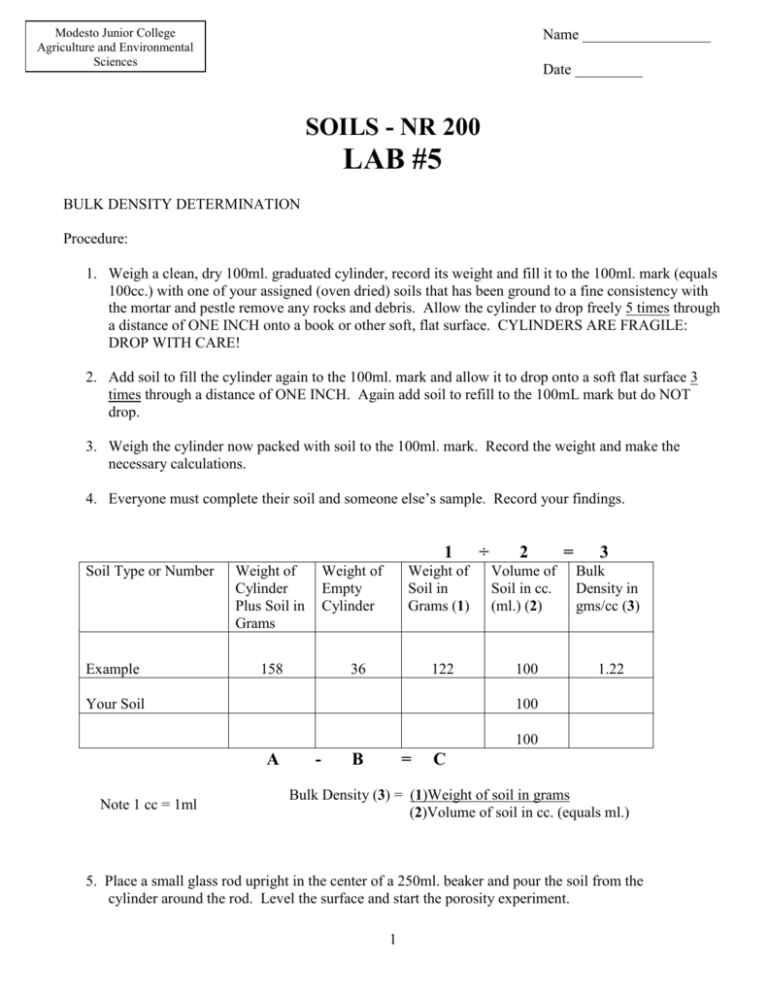Name Soil # Bulk Density Porosity Particle
advertisement

Modesto Junior College Agriculture and Environmental Sciences Name _________________ Date _________ SOILS - NR 200 LAB #5 BULK DENSITY DETERMINATION Procedure: 1. Weigh a clean, dry 100ml. graduated cylinder, record its weight and fill it to the 100ml. mark (equals 100cc.) with one of your assigned (oven dried) soils that has been ground to a fine consistency with the mortar and pestle remove any rocks and debris. Allow the cylinder to drop freely 5 times through a distance of ONE INCH onto a book or other soft, flat surface. CYLINDERS ARE FRAGILE: DROP WITH CARE! 2. Add soil to fill the cylinder again to the 100ml. mark and allow it to drop onto a soft flat surface 3 times through a distance of ONE INCH. Again add soil to refill to the 100mL mark but do NOT drop. 3. Weigh the cylinder now packed with soil to the 100ml. mark. Record the weight and make the necessary calculations. 4. Everyone must complete their soil and someone else’s sample. Record your findings. 1 Soil Type or Number Example Weight of Cylinder Plus Soil in Grams Weight of Empty Cylinder 158 ÷ 2 = 3 Weight of Soil in Grams (1) Volume of Soil in cc. (ml.) (2) Bulk Density in gms/cc (3) 122 100 1.22 36 Your Soil 100 100 A Note 1 cc = 1ml - B = C Bulk Density (3) = (1)Weight of soil in grams (2)Volume of soil in cc. (equals ml.) 5. Place a small glass rod upright in the center of a 250ml. beaker and pour the soil from the cylinder around the rod. Level the surface and start the porosity experiment. 1 POROSITY DETERMINATION Procedure: *** Read the bold items at the bottom of this page first. *** 1. Fill a 100ml. graduated cylinder to the 100ml. mark with tap water. Pour the water SLOWLY onto the soil in the beaker with a glass rod. Stop adding water when it stands at the same level as the soil surface. Do NOT stir the soil or shake the beaker. 2. Determine the amount of water used to exactly fill the pore space in the 100cc. (ml.) volume of soil by subtracting the reading on the side of the graduated cylinder from the original volume. 3. Record your results and make the necessary calculations. Soil Type or Number Volume of Water added to Pore Space in cc. Volume of Soil in cc. (ml.) Percent Pore Space I Percent Pore Space II* by calculation: % = LOOK AT STEPS BELOW 100 - ( Bulk Density x 100) Particle Density Example 53 100 53% 53.96% Your Soil Percent Pore Space I = Volume of pore space (water used) x 100 Volume of Soil Percent Pore Space II = Bulk Density x 100 = Y Y ÷ Particle Density = X 100 – X = Percent Pore Space II * In order to calculate % pore space II, it is first necessary to determine both bulk and particle densities and to apply these figures to the appropriate equation. 2 PARTICLE DENSITY DETERMINATION Definition: The particle density is the weight of a known volume of soil solids. The pore space is not considered. This measurement gives an indication of the density of the parent material. Procedure: 1. Place 50ml. of tap water in a 100ml. graduated cylinder. Carefully weigh a 50-gram sample of dry soil and pour it into the water. 2. Cover the mouth of the graduated cylinder with the palm of the hand and gently rock it back and forth to mix the soil and water thoroughly. 3. Water level prior to washing down the sides = ________ after washing = Second Soil Sample = _________ Dif._________ ______ _________ 4. Rinse the sides of the cylinder with 10 ml of water. Let the mixture stand for 5 minutes. Record numbers above. Now determine the total water used. Total water used = _______ _______ Level after 5 minutes (50 + water used to rinse) Your Soil 2nd. Soil 5. Fill in the blanks below and follow the equation for particle density. _______ Your Soil 1÷2=3 1 Soil Type or Number Example Your Soil Weight of Soil in Grams 50 ÷ Volume of Water and Soil in cc. (ml.) 2 Total Volume of water used in cc. (ml.) 79 Portion of volume occupied by soil in cc. 60 = 3 Particle Density in grams/cc. 19 50 50 A - B Particle Density = = C Weight of soil used_(50) ___ cc.(ml) occupied by soil particles 3 2.63 _______ 2nd. soil Now go back to the porosity determination II and complete those calculations. Name Physical Properties of Soil Soil # Bulk Density Porosity I II 4 Particle Density Name: Date: Bulk Density and Porosity Questions: 1. From your results: a. How does bulk density vary with the amount of clay in the soil? b. How does the percent total pore space vary with the percentage of clay in the soil? 2. Do the bulk densities that you found correspond to what you would expect from the textures of the soils? If not what could be the cause of the discrepancies? 3. Do the values you found for the percent pore space correspond to what you would expect from those textures? If not what could have caused those discrepancies? 4. Would you expect the soil with the greatest amount of pore space to have the most rapid air and water movement? Explain (consider the size of the pore space) 5. Discuss how total pore space and individual pore size distribution characteristics are affected by the soil texture. 6. Explain the difference between permeability and pore space and what influences each? 7. Using the information from the entire class did we find some consistencies with the numbers ie in terms of texture……..please explain your findings. 5






